As the epitome of a rock ‘n’ roll legend, Slash needs no introduction. Born Saul Hudson in Hampstead, London, in 1965, this iconic guitarist has left an indelible mark on the world of music. His signature sound & style are entwined with his instrument which makes some wonder, “what guitar does slash play??”
With his distinctive top hat, curly hair, and unparalleled guitar skills, he has become one of the most recognizable figures in rock history. From his early days with Guns N Roses to his fruitful solo career and collaborations with renowned artists across genres, Slash’s virtuosity and artistic sensibility have captivated audiences worldwide. In this article we cover some of his tools of the trade, as well as some of the bands he’s been involved in.
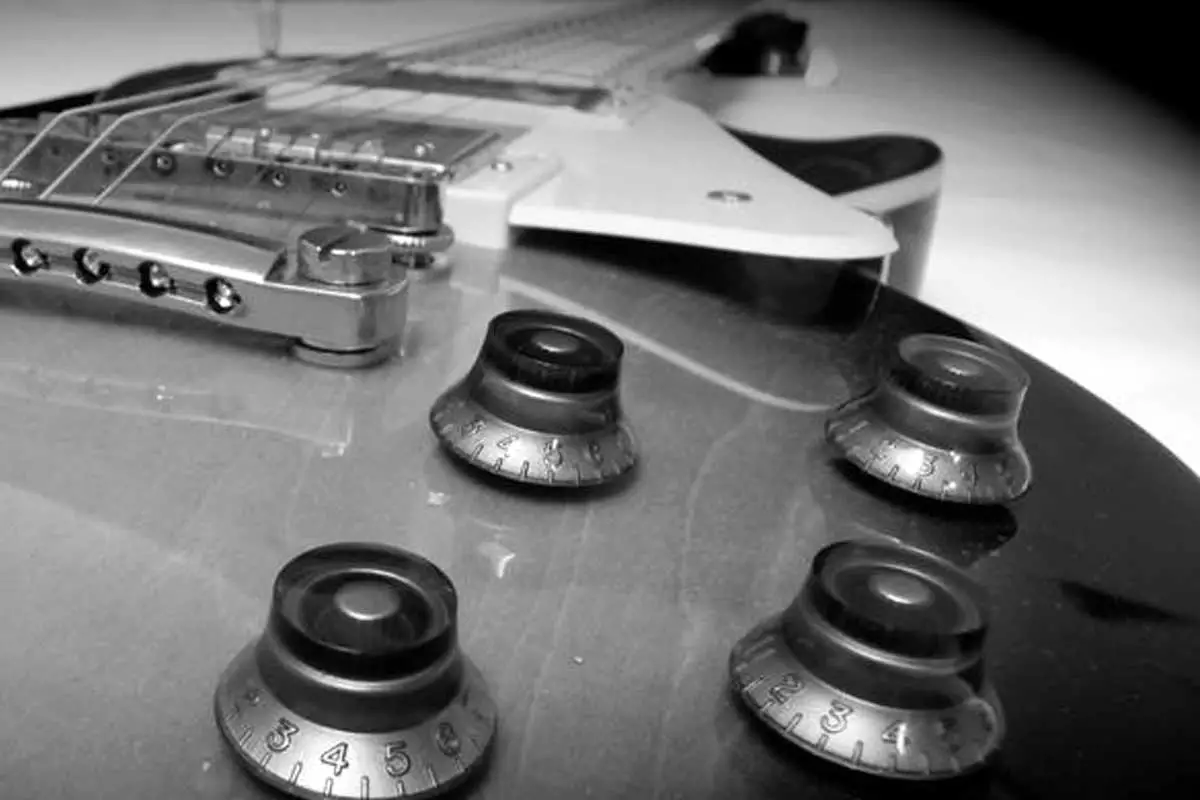
Brief Overview of Slash as a Legendary Guitarist
Slash’s journey as a guitarist began at an early age when he discovered his passion for music. He was deeply influenced by legendary guitarists such as Jimmy Page, Jimi Hendrix, and Eric Clapton.
Drawing inspiration from their fiery playing styles and unique tones, Slash honed his skills with relentless dedication. In 1985, Slash co-founded Guns N Roses alongside childhood friend Axl Rose.
Their debut album “Appetite for Destruction” took the music world by storm in 1987, establishing Guns N Roses as one of the greatest rock acts of all time. With slashing riffs and soulful solos that oozed attitude and emotion, Slash’s guitar work elevated the band’s sound to new heights.
Despite internal conflicts within Guns N Roses that eventually led to its temporary dissolution in the mid-1990s, Slash continued to evolve as a musician. He embarked on successful collaborations with artists like Michael Jackson and worked on various side projects before ultimately forging ahead with his solo career.
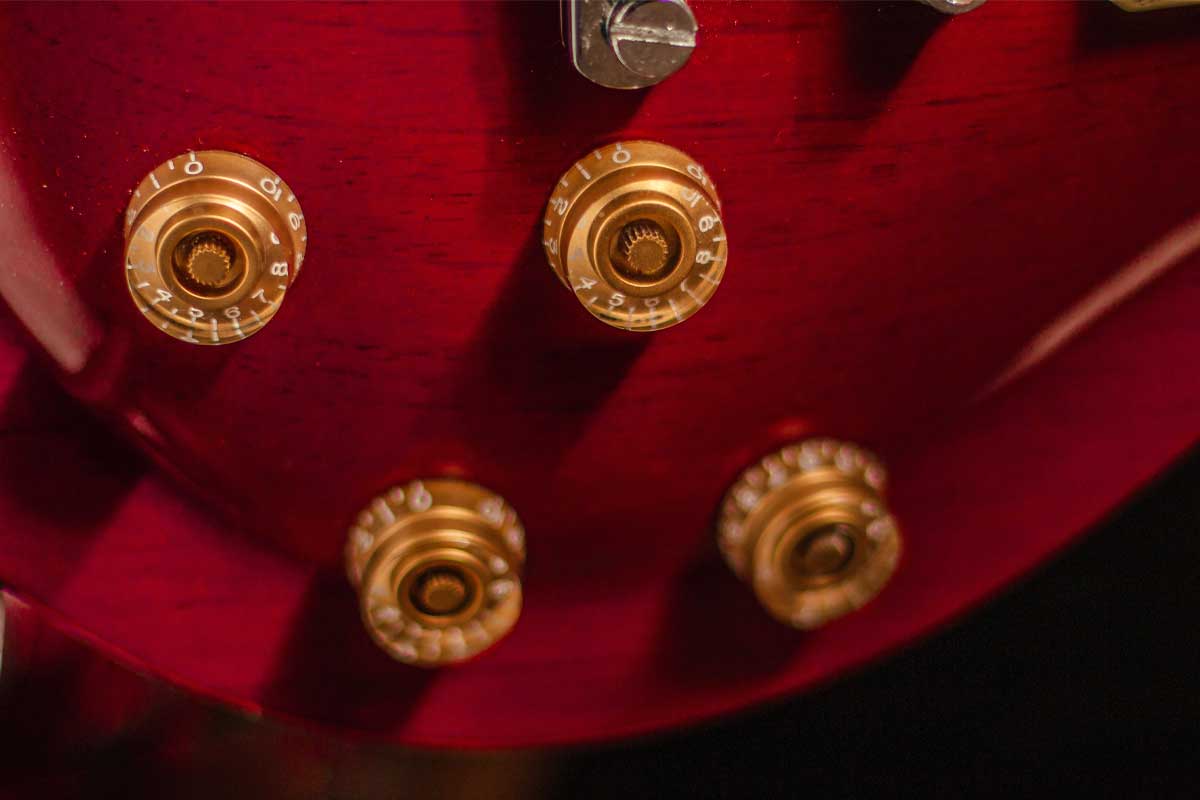
Teaser About the Guitars Slash Plays
Now let us delve into the heart of what makes Slash’s sound so distinctive: his choice of guitars. Over the years, this legendary guitarist has wielded an array of instruments, each contributing to his unique sonic palette.
However, one particular guitar holds a special place in Slash’s arsenal, providing the foundation for his signature tone and serving as an extension of his musical expression.
Brace yourself as we explore the world of the guitar that has become synonymous with Slash’s name: the Gibson Les Paul.
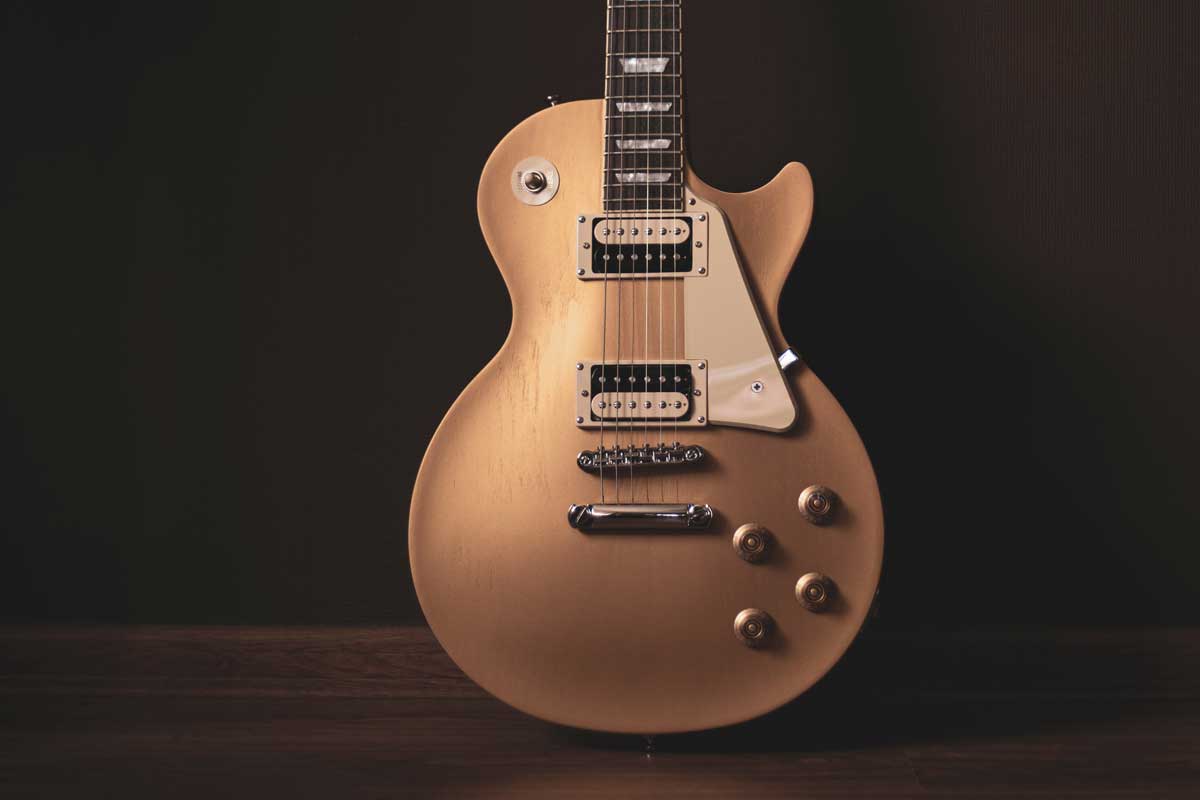
Background on Slash’s Guitar Preferences
Early influences & guitar choices
Slash, born Saul Hudson, was heavily influenced by iconic guitarists who shaped the landscape of rock music. From a young age, he gravitated towards the melodic prowess and soulful playing of legends such as Jimmy Page and Joe Perry.
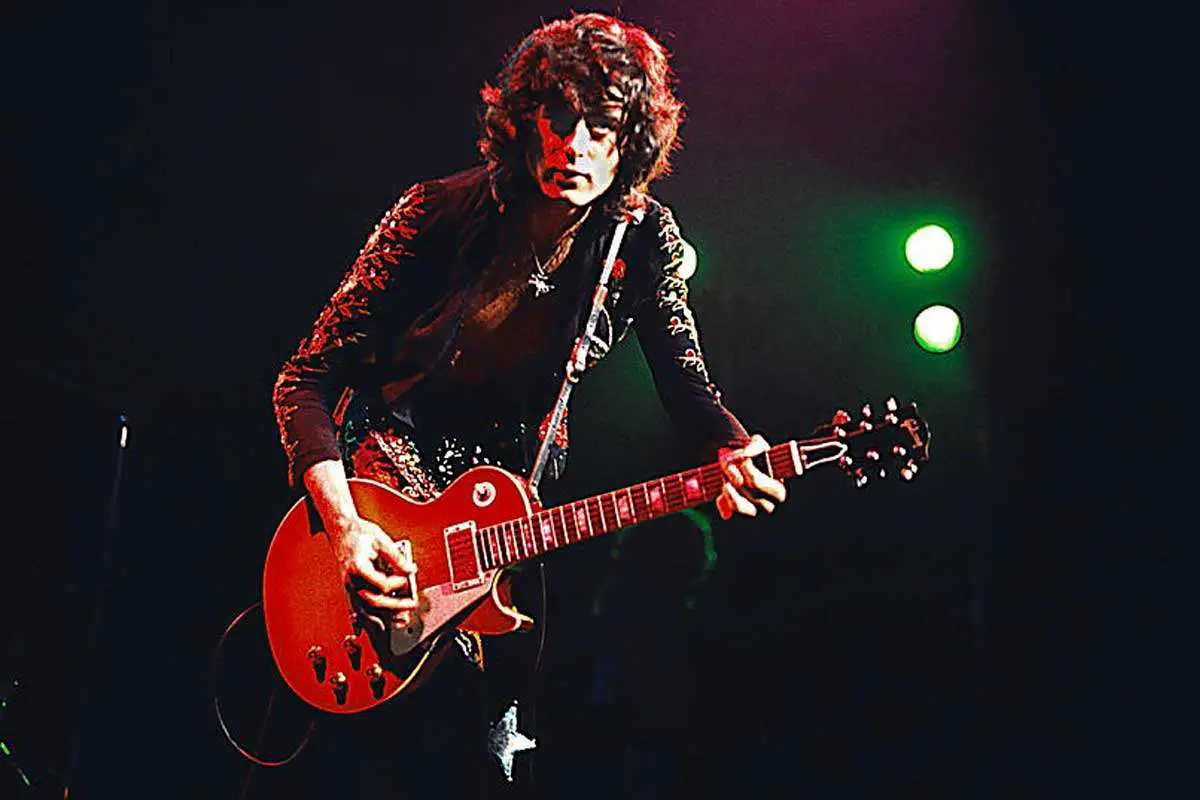
Their expressive styles served as a catalyst for Slash’s musical journey, inspiring him to explore the depths of his own creativity on the guitar. These influential players not only impacted Slash’s overall approach to music but also played a significant role in shaping his choice of instrument.
As he delved deeper into their discographies, he discovered their affinity for the Gibson Les Paul, an electrifying solid-body guitar known for its warm tone and sustain. Intrigued by its capabilities, Slash began experimenting with various models to find his perfect match.
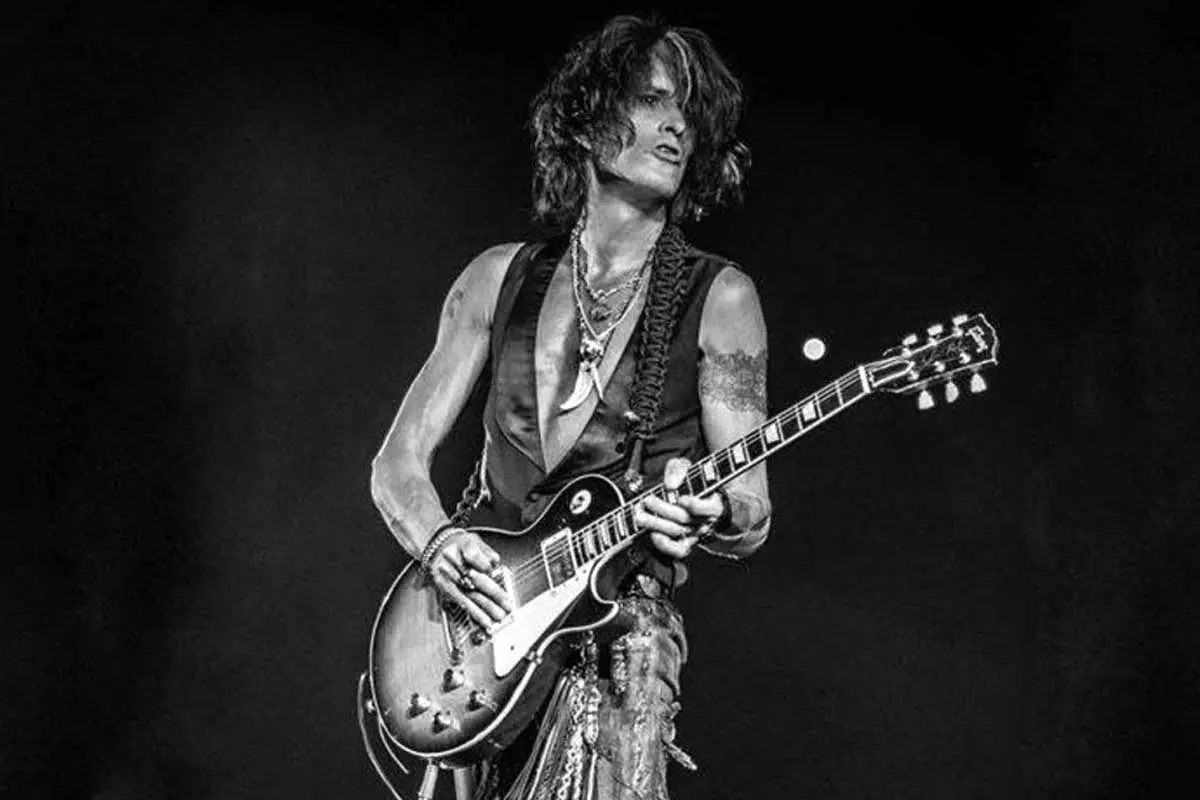
Iconic players who inspired Slash’s style
Jimmy Page, renowned for his work with Led Zeppelin, captivated Slash with his innovative use of blues-infused riffs and intricate fingerpicking techniques.
The raw energy and undeniable charisma exuded by Page on stage ignited a fire within the young guitarist, pushing him to channel that same level of passion into his own playing. Another towering figure who left an indelible mark on Slash was Joe Perry from Aerosmith.
Perry’s gritty blues-rock style combined with captivating stage presence became a blueprint for Slash’s development as both a musician and performer. The way Perry effortlessly blended technical proficiency with emotion resonated deeply with him and encouraged him to push boundaries in pursuit of sonic excellence.
These influences provided Slash with diverse musical palettes from which to draw inspiration. As he absorbed their approaches into his own arsenal of techniques, an unmistakable signature sound began to emerge—a blend of raunchy blues licks interwoven with melodic sensibility that would soon define his own unique style.
His early experiences with different guitar brands
Before settling on the Gibson Les Paul, Slash embarked on a journey of exploration, trying out various guitar brands to discover the instrument that would become an extension of his musical identity. In his early days, he experimented with Fender Stratocaster & Fender Telecaster, captivated by their versatility and bright tones.
However, it was the Gibson brand that ultimately captured Slash’s heart and ear. Drawn to its rich heritage and iconic status in rock music history, he found that Gibsons offered the right balance of power, sustain, and warmth that resonated perfectly with his desired sound.
This affinity for Gibson guitars became evident as Slash continued to experiment with different models throughout his career. From Les Pauls to Explorers and SGs, each instrument added its own unique flavor to his sonic palette.
While Slash explored various brands during his formative years as a guitarist, it was through these experiences that he discovered the magical combination of passion-filled playing and the distinct characteristics offered by certain guitar models. These early influences and explorations laid the foundation for Slash’s lifelong love affair with Gibson guitars – a relationship that would shape not only his sound but also cement him as one of rock’s most revered axemen.
The Gibson Les Paul: Slash’s Weapon of Choice
Overview of the Gibson Les Paul model
The Gibson Les Paul is an iconic guitar that has become synonymous with rock and roll. Introduced in the early 1950s, it quickly gained popularity among guitarists due to its solid body construction, rich tone, and sustain.
The Les Paul has a distinctive double-cutaway design, a set neck, and typically features two humbucking pickups. It offers a versatile range of sounds, from warm and bluesy to thick and aggressive.
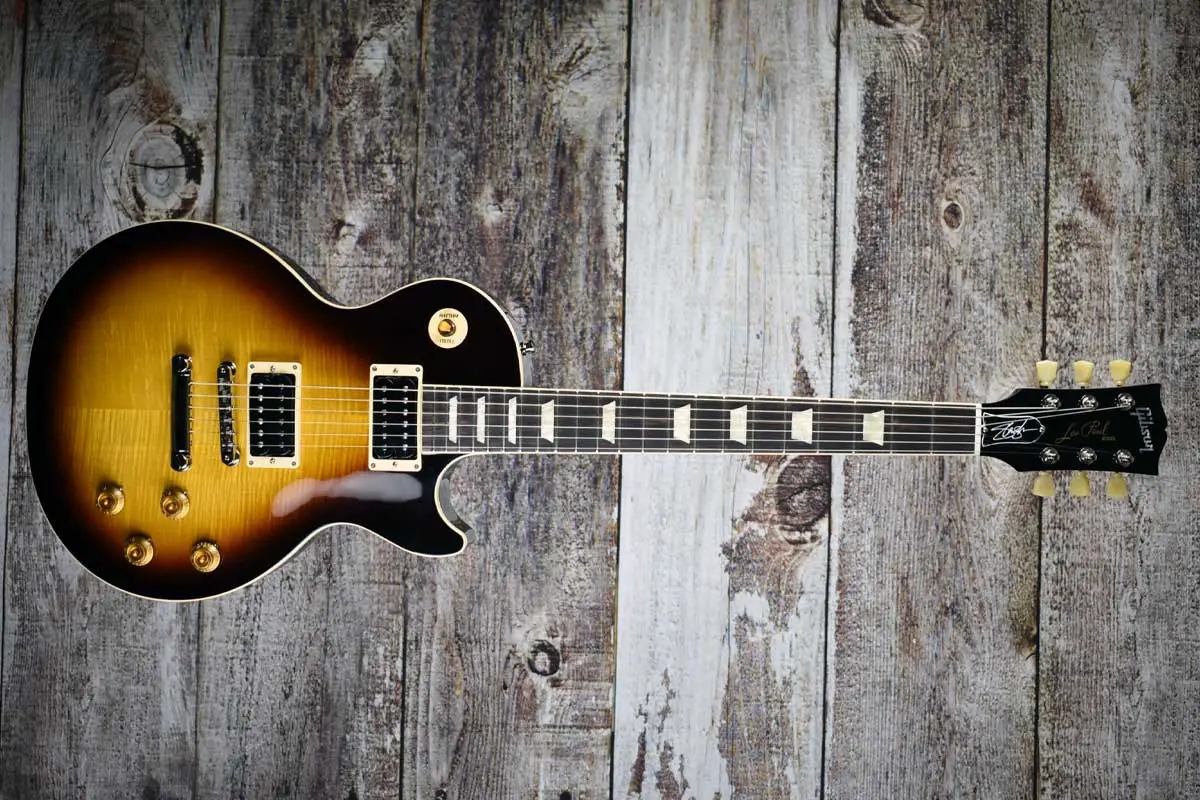
Historical significance & popularity among rock guitarists
The Gibson Les Paul has left an indelible mark on the history of music. Its powerful sound was favored by legendary guitarists such as Jimmy Page, Eric Clapton, and of course, Slash himself.
With its thick midrange tones and sustain for days, the Les Paul became the weapon of choice for those seeking to create soaring solos or chunky rhythm riffs that cut through the mix like a hot knife through butter.
Key features that make it a favorite for many musicians
What sets the Gibson Les Paul apart from other guitars is not only its rich heritage but also its exceptional craftsmanship.
Each instrument is meticulously built by skilled luthiers using high-quality tonewoods like mahogany for the body and maple for the top.
The Les Paul’s dual humbucking pickups contribute to its signature tone by delivering powerful output with reduced noise interference.
Additionally, it boasts a comfortable playing experience thanks to its weight distribution and smooth fretwork.
Slash’s specific Gibson Les Paul models throughout his career
Throughout his illustrious career, Slash has had a special affinity for various models within the Gibson Les Paul family. One notable instrument is his “Appetite for Destruction” Les Paul Standard, which he heavily modified to suit his unique playing style.
Slash replaced the original pickups with Seymour Duncan Alnico II Pro humbuckers, giving it a distinctive tone that is both punchy and articulate. The guitar’s look is equally iconic, featuring a worn tobacco sunburst finish and a skull-shaped graphic on the headstock.
Gibson also collaborated with Slash to create several signature Les Paul models tailored specifically to his preferences. These guitars feature custom appointments like Slash’s preferred neck profile, unique finishes, and hardware choices.
Notably, these signature models incorporate modern improvements such as weight relief chambers for enhanced comfort during long performances without sacrificing tone or sustain. With these collaborative efforts between Gibson and Slash, guitarists can now channel their inner rock god and access the same legendary sound that has defined Slash’s career for decades.
Acoustic Guitars He’s Played
Slash is best known for his electric guitar work, specifically his use of Gibson Les Pauls. He has, however, been seen on occasion playing acoustic guitars. Slash has used the following acoustic guitars:
Gibson J-45: Slash has been spotted playing the Gibson J-45, a renowned acoustic guitar known for its warm and balanced tone. The J-45 is a popular choice among many artists and is often associated with folk, country, and rock genres.
Martin D-28: Slash has also been seen playing the Martin D-28, another classic acoustic guitar known for its rich and resonant sound. The D-28 is prized for its powerful projection and has been a favorite among folk and blues musicians.
Slash’s acoustic guitar playing has been less frequent and prominent in comparison to his electric guitar work. As a result, he may not be as well-known for specific acoustic guitar models as he is for his iconic electric guitars.
Slash’s Snakepit
“Slash’s Snakepit” emerged as a compelling side project during the mid-1990s when Slash, the renowned guitarist of Guns N’ Roses, decided to take a hiatus from the band. The lineup featured some familiar faces, including Gilby Clarke and Matt Sorum from Guns N’ Roses, alongside Mike Inez and Eric Dover. Together, they released their debut album “It’s Five O’Clock Somewhere” in 1995. The album’s captivating blend of hard rock, blues, and classic rock elements showcased Slash’s exceptional guitar skills through soulful solos and energetic riffing. Tracks like “Beggars & Hangers-On,” “Good to Be Alive,” and “Neither Can I” received praise from fans and critics alike, establishing the project as a successful venture for Slash outside of Guns N’ Roses.
Throughout his time with “Slash’s Snakepit,” the guitar virtuoso predominantly relied on his beloved Gibson Les Paul guitars, which had become his signature instruments. Whether it was the powerful tones of the Gibson Les Paul Standard or the refined elegance of the Les Paul Custom models, Slash’s guitar work resonated with listeners, complementing the band’s diverse musical style. The Les Paul’s rich and dynamic sound served as the perfect canvas for Slash’s expressive playing, contributing to the band’s distinctive sound on their debut album and beyond.
Despite its brief existence as a band, “Slash’s Snakepit” left a lasting impact on Slash’s solo career and cemented his status as one of rock’s most influential guitarists. The project allowed him to explore different musical avenues and collaborate with talented musicians, serving as a creative outlet during his hiatus from Guns N’ Roses. The success of “It’s Five O’Clock Somewhere” demonstrated that Slash’s artistry extended far beyond his iconic work with Guns N’ Roses, showcasing his ability to thrive in new and exciting musical territory.
Velvet Revolver
Velvet Revolver, a supergroup formed in 2002, united former members of Guns N’ Roses and Stone Temple Pilots. Slash took on the role of lead guitarist, alongside Duff McKagan on bass and Matt Sorum on drums, all previously associated with Guns N’ Roses. They were joined by Scott Weiland, the former frontman of Stone Temple Pilots, and Dave Kushner on rhythm guitar. The band’s music was a fusion of hard rock, alternative rock, and glam metal, creating a powerful and dynamic sound.
As the lead guitarist of Velvet Revolver, Slash played a pivotal role in defining the band’s identity. He showcased his iconic guitar style and distinctive tone, mainly using his favored Gibson Les Paul guitars, notably the Gibson Les Paul Standard. The Les Paul’s full-bodied and resonant sound perfectly complemented the band’s hard-hitting tracks, adding depth to their performances and delivering memorable guitar solos.
Velvet Revolver gained commercial success with their debut album, “Contraband” (2004), featuring hit singles like “Slither” and “Fall to Pieces.” The album received critical acclaim and soared to the top of the charts, establishing Velvet Revolver as a prominent force in the rock music scene. Slash’s exceptional guitar work displayed his versatility and reinforced his reputation as one of the finest guitarists of his generation.
Despite the initial triumphs, internal conflicts and substance abuse issues plagued the band, leading to lineup changes and challenges. Although they released their second album, “Libertad,” in 2007, Velvet Revolver eventually went on hiatus. Despite the relatively brief existence of Velvet Revolver, the group’s impact on rock music remains enduring, and Slash’s role as the lead guitarist further solidified his legacy as an influential and legendary figure in the genre.
Slash Ft. Myles Kennedy & the Conspirators
“Slash feat. Myles Kennedy & The Conspirators” is a collaborative project led by Slash, the iconic guitarist known for his work with Guns N’ Roses and Velvet Revolver. The band was formed in 2010, and its core members included Slash on lead guitar, Myles Kennedy as the lead vocalist, and The Conspirators, a group of talented musicians that included Todd Kerns on bass, Brent Fitz on drums, and Frank Sidoris on rhythm guitar.
As the driving force behind the project, Slash played a crucial role as the lead guitarist, bringing his signature guitar style and unparalleled skills to the forefront. Myles Kennedy, the accomplished vocalist, added his powerful and versatile voice to the mix, making the band’s sound distinctive and captivating. The Conspirators provided a solid and dynamic rhythm section, contributing to the band’s hard-rocking, bluesy, and melodic style.
Throughout his tenure with “Slash feat. Myles Kennedy & The Conspirators,” Slash continued to showcase his preference for Gibson Les Paul guitars, particularly the Gibson Les Paul Standard. The Les Paul’s thick and warm tones were a perfect match for the band’s musical direction, allowing Slash to deliver soulful and expressive guitar solos. His guitar work remained an essential element in the band’s sound, blending seamlessly with Myles Kennedy’s powerful vocals and the band’s overall energy.
The band released several successful albums, including “Apocalyptic Love” (2012), “World on Fire” (2014), and “Living the Dream” (2018). These albums received positive reviews from fans and critics, further solidifying Slash’s position as a prominent figure in rock music. “Slash feat. Myles Kennedy & The Conspirators” provided a platform for Slash to explore new musical territories and continue his legacy as a virtuoso guitarist and songwriter.
Amps & Effects: Enhancing Slash’s Sound
Marshall JCM800: Classic British Tone Synonymous with His Sound
When discussing Slash’s iconic guitar tone, it is impossible to overlook his longstanding relationship with the Marshall JCM800 amplifier.
This British-made, all-tube amp has become synonymous with the raw, aggressive sound that defines his signature playing style.
The JCM800 offers a powerful and distinctive tone, characterized by its tight low-end response, creamy midrange presence, and soaring high frequencies that cut through any mix.
Slash’s affinity for this amplifier stems from its ability to deliver the perfect balance between grit and clarity, providing the ideal foundation for his blistering guitar solos and hard-hitting riffs.
Customized Marshall Jubilee Series: Personalized Modifications
While the JCM800 remains a staple in Slash’s rig, he has also ventured into customizing amplifiers to suit his specific needs. One notable example is his personalized modifications to the Marshall Jubilee series.
These modifications involve fine-tuning various components like gain stages, EQ circuits, and power sections to achieve a more tailored sound. By tweaking these elements, Slash has managed to push the boundaries of what was already an exceptional amp design, taking it closer to his desired tonal nirvana.
Effects Pedals in Slash’s Rig
Slash’s arsenal of effects pedals plays a crucial role in shaping his expressive and dynamic guitar sound. While he favors simplicity over excessive gadgetry, each pedal strategically chosen adds depth and character to his playing.
Wah Pedal: Adding Expressive Dynamics to Solos
One effect pedal that has become an indispensable part of Slash’s setup is the wah pedal. When engaged at just the right moments during solos or melodic passages, this pedal adds a touch of vocal-like expression to his playing.
It allows him to emphasize certain notes, inject emotion, and create a more dynamic and engaging performance. The sweeping motion of the wah pedal’s treadle enables Slash to sculpt his tone in real-time, making each note sing and cry with unparalleled musicality.
Delay Pedal: Creating Atmospheric Textures in His Playing
Another vital component in Slash’s effects chain is the delay pedal. By adding subtle repeats and echoes to his guitar signal, this effect creates depth and spaciousness, giving his solos an ethereal quality.
The carefully dialed-in delay settings allow Slash’s notes to linger in the sonic landscape, transforming his playing into a rich tapestry of cascading soundscapes. Whether he’s conjuring haunting melodies or building dramatic tension, the delay pedal is an essential tool that elevates the atmospheric aspect of Slash’s sound.
Tube Screamer: Boosting Gain for Extra Sustain
To enhance the drive and sustain of his guitar tone when needed, Slash frequently incorporates a Tube Screamer overdrive pedal into his rig. This iconic stompbox adds a touch of grit while emphasizing midrange frequencies, pushing amplifiers into natural tube saturation.
By subtly cranking up the gain control on this pedal, Slash achieves that sweet spot where every note blooms with enhanced sustain and harmonic richness. The Tube Screamer injects an extra layer of intensity into solos or heavier sections without sacrificing clarity or overpowering the fundamental character of his amplifier.
It is undeniable that both amps and effects play a pivotal role in defining Slash’s unmistakable guitar sound. From embracing classic British tones with Marshall JCM800 amplifiers to customizing amplifiers for personalized modifications such as those seen in the Marshall Jubilee series—Slash is constantly refining and evolving his setup to achieve tonal perfection.
Additionally, carefully chosen effects pedals like the wah pedal, delay pedal, and the Tube Screamer overdrive further enhance his sonic palette, adding expressive dynamics, atmospheric textures, and boosted gain to his playing.
It’s through this meticulous combination of gear that Slash crafts his musical voice—a voice that has captivated millions of fans around the world for decades.
Strings, Picks, & Accessories
Slash’s Preferred String Gauge and Brand
When it comes to achieving his signature tone, Slash is meticulous about every aspect of his setup, right down to the strings. He prefers a slightly heavier gauge for his guitar strings, typically opting for a set of 11-52 gauge strings. This choice allows him to achieve the perfect balance between playability and tonal richness.
The thicker strings provide him with added sustain and a fuller sound, allowing each note to ring out with clarity. One of Slash’s go-to string brands is Ernie Ball, known for their high-quality craftsmanship and exceptional durability.
His Choice of Picks for Optimal Tone
A guitar pick may seem like a small accessory, but for Slash, it plays a crucial role in shaping his tone and technique. Over the years, he has developed a preference for picks made from celluloid material. Celluloid picks have certain flexibility that allows Slash to maintain control while playing intricate solos or aggressive rhythm parts effortlessly.
Furthermore, celluloid picks offer a warm tonality that complements Slash’s playing style perfectly. The thickness of the pick also influences the attack and feel.
Slash usually leans towards medium-to-heavy gauges (around 0.88mm – 1.14mm) to strike the sweet spot between precision and power in his playing. However, it’s important to note that he often experiments with different picks during recording sessions or live performances to explore new textures and sounds.
Frequently Asked Questions
What guitar does slash use in sweet child o mine?
The specific one he used for recording the Guns N Roses hit “Sweet Child o’ Mine” is the Gibson Les Paul Standard. The particular Gibson Les Paul he used was a 1959 model, which is often referred to as the “Appetite for Destruction” Les Paul.
Does Slash ever play a strat?
While Slash is known for his preference for the Les Paul’s thicker tone & humbucker pickups, he’s been known to use other guitars on occasion.
For example, here’s a rare clip on the shoot for the Guns N Roses “November Rain” music video:
What does Slash tune his guitar to?
Slash typically tunes his guitar to standard tuning, which is:
E – A – D – G – B – E
Slash may also use different tunings for specific songs or performances. However, he uses standard tuning for the majority of his work, particularly with Guns N Roses.
Conclusion
In essence, understanding the minutiae of Slash’s gear choices reveals not only his dedication as an artist but also how these selections contribute to shaping his iconic sound.
From wielding Gibson Les Paul guitars with their legendary sustain and rich tones to carefully selecting string gauges that offer optimal playability without sacrificing depth, Slash’s attention to detail is evident.
His choice of celluloid picks allows him to maintain control and finesse while delivering the punch and aggression that define his style. By paying attention to every aspect of his setup, Slash continues to inspire guitarists worldwide and influence generations of rock music enthusiasts.
So, next time you pick up a guitar, take a moment to consider how even the smallest choices can make a significant impact on your playing experience, just as they do for the legendary Slash himself. Embrace the artistry in crafting your own unique sound!
